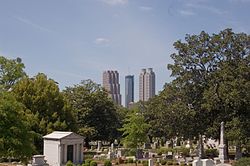Oakland Cemetery (Atlanta)
|
Oakland Cemetery
|
|

Oakland Cemetery with the Atlanta skyline in the background
|
|
| Location | 248 Oakland Avenue, SE, Atlanta, Georgia |
|---|---|
| Coordinates | 33°44′55″N 84°22′17″W / 33.74861°N 84.37139°WCoordinates: 33°44′55″N 84°22′17″W / 33.74861°N 84.37139°W |
| Area | 48 acres (190,000 m2), 2 buildings, 31 objects |
| Built | 1850 |
| NRHP Reference # | 76000627 |
| Added to NRHP | April 28, 1976 |
Oakland Cemetery is one of the largest cemeteries green spaces, in Atlanta, Georgia, U.S. Founded as "Atlanta Cemetery" in 1850 on six acres (2.4 hectares) of land southeast of the city, it was renamed in 1872 to reflect the large number of oak and magnolia trees growing in the area. By that time, the city had grown and the cemetery had enlarged correspondingly to the current 48 acres (190,000 m2). Since then, Atlanta has continued to expand, so that the cemetery is now located in the center of the city. Oakland is an excellent example of a Victorian-style cemetery, and reflects the "garden cemetery" movement started and exemplified by Mount Auburn Cemetery in Massachusetts.
The original 6 acres (24,000 m2) of Oakland remains one of the oldest historical plots of land in Atlanta, most of the rest of the city having been burned in 1864. Because of its age and location, the cemetery directly reflects the history and changing culture of the City of Atlanta and the significant events it has seen. Names of Atlanta streets, buildings, parks, subdivisions, and more can be found within the cemetery gates. An estimated 70,000 people are interred at Oakland, and while the last plots were sold in 1884, there are still regular burials today. These are largely conducted on family-owned plots or areas owned by Atlanta (one of the most recent being former mayor Maynard Jackson, whose plot was contributed by the city).
Immediately upon entering the gates of Oakland is found the original 6 acres (24,000 m2) purchased for use as the Atlanta Cemetery in 1850. The gates and perimeter walls were not erected until 1896, the date engraved on the keystone of the gates' highest arch. After a short distance along a brick walkway, Oakland's first resident since its establishment can be found. Dr. James Nissen was a medical doctor visiting Atlanta who fell ill and died in 1850. Legend has it that Dr. Nissen shared a common fear of the day, being buried alive. Therefore, before his death he asked that his jugular vein be cut prior to his burial to ensure he did not wake up later under the ground. Being the oldest grave in Oakland since its designation as a city cemetery, Nissen's headstone is nearly completely worn away by the passage of time and the elements. The inscription is only known due to an extensive survey of Atlanta cemeteries performed in the 1930s by Franklin Garrett. Back towards the main gates of Oakland on a plot donated by the City of Atlanta lies Martha Lumpkin Compton. The daughter of Governor Wilson Lumpkin, from 1843 until 1845 Atlanta was known as "Marthasville" in her honor.
...
Wikipedia
